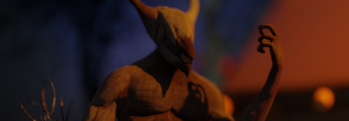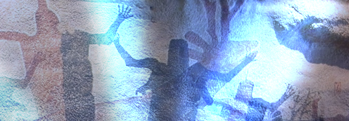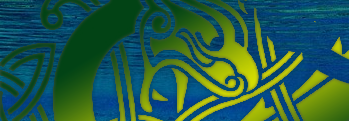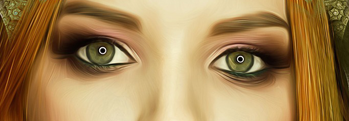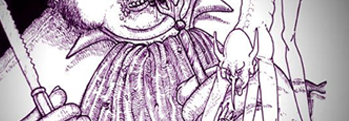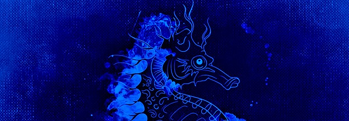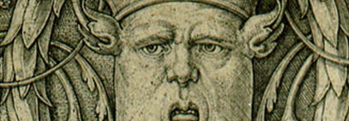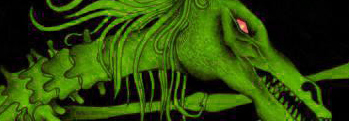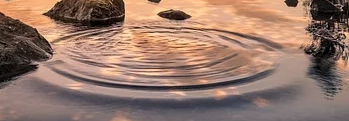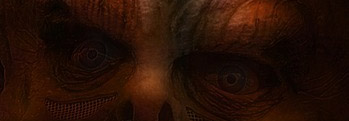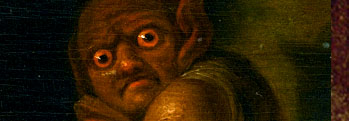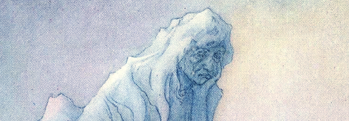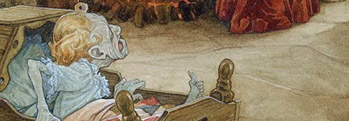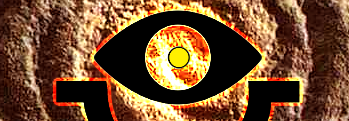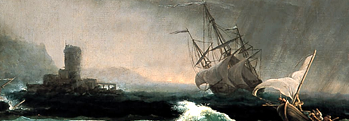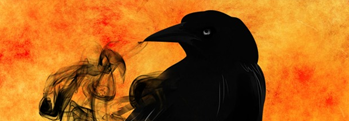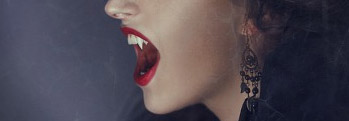The Great Wyrms of Ireland
Irish and Celtic myths and legends, Irish folklore and Irish fairy tales from Irish Gods and Monsters
Dragons of old, na péisteanna
 The dragons of Ireland were not like the dragons of other places, since they did not have wings or often even claws, and only rarely did they breathe fire, if at all! The were called the Ollphéisteanna, which means “great worms” or “mighty reptiles”, the terrible serpents of the world that was.
The dragons of Ireland were not like the dragons of other places, since they did not have wings or often even claws, and only rarely did they breathe fire, if at all! The were called the Ollphéisteanna, which means “great worms” or “mighty reptiles”, the terrible serpents of the world that was.
The greatest among them was called Caoránach, and some stories tell she was defeated by Fionn Mac Cumhaill, while others insist it was Saint Patrick that put an end to her. Not only was she the mother of all of the great worms of Ireland, but she was said to be the mother of all demons too!
Fionn and the Fianna heard of an old witch who was terrorising the lands around what we call Donegal today, so they felled her with an enchanted arrow. One thing only were they warned against – they must not under any circumstances break her thigh bone, whether she was alive or dead.
Naturally enough of course that's exactly what Conán, one of the Fianna, did, and forth from the crack crawled a small and hairy worm, which quickly grew into a mighty monster which ate all the cattle of Ireland. As it was Conán's fault he was blamed and insulted for this creature's existence, so in a fury he leapt into its mouth and slew it from within, staining the rocks around Lough Dearg red and giving the lake its name.
Other stories yet tell that she was not slain at all, but dwells still in the depths of Lough Dearg.
One of the old great serpents is said to haunt Sligo's Church Island. It was named after a church built there in the sixth century by Lommán of Trim and replaced in the medieval period. That lasted until 1416 when a massive conflagration, apparently accidental, consumed the church and destroyed many manuscripts, a book known as the Leabhar Gearr and multiple other documents including foreign manuscripts. According to the Annals of the Four Masters, a legendary harp and ornamental cup were also destroyed.
Whether it was the possessions of those who lived on the island or other church artifacts is unknown, but Church Island was also reputedly the source of hidden treasure.
And in case anyone wishes to seek it out, beware that legend has it that it is “guarded by a serpent which lies beneath the large stone which covers the crock of gold”. The legend states that a life must be lost before the treasure can be recovered.
A newspaper report gave its view that it “would seem a simple island to search from end to end and as a matter of fact this has been attempted, but an unforeseen ‘something’ invariably occurred and stopped the work. One such event in the early 20th century saw two botanists in search of rare mosses and ferns on the island when a thunderstorm broke and they fled the island, “their lifeless bodies were found the next day”.
On top of a hill in townland of Garrycummer is a tarn called Lough Thuile, with no outlet, and in whose waters strange lights dance when a death is about to occur nearby. An attempt was made to drain it hundreds of years ago, but mysteriously all the houses in the valley below caught fire at the same time! It was said to be the doing of the wyrm of the lake, a huge eel which appears there occasionally. It was said that no man could swim it for fear the monster would suck him down as he crossed the middle. There are many plover, wild duck and wild geese but the lake contains no fish of any kind.
There is similar folklore about the draining of Lough Muskry in the Glen of Aherlow, when they tried to drain it, their houses ended up on fire back at home. Related tales are told of Lough Muskry - there is a story of a lake monster.
Péisteanna would sleep or lie in wait at the bottom of lakes and rivers, or sometimes in the deep underground caverns and crevices which lie beneath many parts of Ireland. They were also known to inhabit marshy or swampy areas, and were mingled with the idea of disease and rot. Péists were particularly associated with the old Fomors and their sorcery, and it was against their wyrm-magic that the Tuatha De Danann strove when freeing Ireland from their gnarled grasp.
The blood of the worm was much feared as toxic and poisonous, as the great healer the Tuatha Dian Cécht demonstrated when disposing of three that had grown in an infant's breast – they were burned to ashes and the ashes were cast into a river, whose waters turned black and still, and every living thing in it died.
The medieval Irish book Acallam na Senórach tells how the ancient hero Caeilte taught the deeds of the Fianna to Saint Patrick. Once upon a time, he said, it was their job to rid the land of these serpents, but there were some they would not touch.
Eochaid Lethderg, King of Leinster, enquired of Caeilte:
“What cause had Fionn and the Fianna that, out of every other monster ye banished out of Ireland, they killed not the reptile we have in the glen of Ros Enaigh?”
Caeilte replied:
“Their reason was that the creature is the fourth part of Mesgedra‘s brain, which the earth swallowed there and converted into a monstrous worm.”
Mesegdra was an earlier Irish king who had been killed in battle by Conall Cernach, and his brain had been scooped from his head, shaped into a sling stone and soaked in lime to preserve it as a trophy, a common practise at the time. The brain-ball was stolen and used to severely injure and eventually kill King Conchobar mac Nessa of the Northlands, and the worm was part of a blood feud the Fianna had no wish to re-ignite.
While the presence of serpentine motifs can be found in much pre-Christian art in Ireland, they truly became part of popular Irish culture with the coming of Christianity, for the Saints, priests and monks were reputed to have had many battles with these fierce creatures!
They became identified with the old pagan ways and were held responsible for the formation of many lakes and rivers in their death throes, or when they tried to make good their escape, as happened when Saint Patrick approached the Shannon. A mighty oilliphéist heard he was coming, and carved out the course of the river Shannon as it slid towards the Atlantic.
Ploughing through countries can be hungry work though, and some say the creature ate a drunken piper on his way. Being too drunk to notice, the piper kept playing until the oilliphéist spat him out in annoyance before it slid into the depths of the ocean.
 And there are some who say that the péisteanna still live in Ireland's deepest lakes and oldest bogs! In October of 1871 the story of an encounter was published in the local newspapers in County Clare:
And there are some who say that the péisteanna still live in Ireland's deepest lakes and oldest bogs! In October of 1871 the story of an encounter was published in the local newspapers in County Clare:
"A party of strangers staying at Kilkee, composed of several ladies and some gentlemen - one of whom is a well-known clergyman in the north of Ireland were out for a walk at a place known as the Diamond Rocks.
All of a sudden, their attention was arrested by the appearance of an extraordinary monster, who rose from the surface of the water about seventy yards from the place where they were standing.
It had an enormous head, shaped somewhat like a horse, while behind the head and on the neck was a huge mane of seaweed-looking water; the eyes were large and glaring, and, by the appearance of the water behind, a vast body seemed to be beneath the waves."
As recently as 2003, sonar scans of the lake of the Torc in Kerry, also known as Muckross lake, found something very odd – a fish the size of a two storey building! It may be no coincidence then that one of the tallest mountains nearby is called Cnoc na Péiste, or the “Peak of the Serpent.”
Lough Dearg is marked on the map below!
More Irish Gods and Monsters
The Irish elk, or more properly deer, was the single largest species of deer which has ever existed. They were slightly larger than the modern moose, but their spread of antlers was vast - up to four meters or thirteen feet across in some specimens! These magnificent creatures roamed the plains and forests of Ireland and Europe before, during and a ... [more]
It was a fine day in Ireland many years ago when Fionn and his Fianna took a fancy to go out hunting. Warm was the sun amid the whispering glades of ancient forests, gentle was the breeze and sweet the scent of summer flowers in its bosom. Sweeter yet was the sight of a mighty deer to the eyes of the hunters, and so they gave chase, howling with de ... [more]
It is during the darkest winter nights that we sit inside our houses and listen to the wind hammering at our windows and doors, as if it had a mind and will of its own – as if it wished to do us harm! The old people of Ireland believed that was the literal truth, that there were demons of the air, or demna aeóir thronging about the ... [more]
No tale of ancient Ireland could be complete without mentioning the Fomorians, dreaded foes of the Tuatha Dé Danann and all who came to conquer Ireland. The meaning of their name is debated even today, although most agree that the first part, fó, means “from below” or “nether” and the latter part means “t ... [more]
The dragons of Ireland were not like the dragons of other places, since they did not have wings or often even claws, and only rarely did they breathe fire, if at all! The were called the Ollphéisteanna, which means “great worms” or “mighty reptiles”, the terrible serpents of the world that was. The greatest among t ... [more]
It's well known that the people of Ireland are gifted in poetry, music, writing and the arts, and many have to come to these shores to admire these works. But there is one who moves through the misty glens and dappled glades of Ireland and it is the poets who whisper to her in the darkest hours of the night, hoping for an answer! This fairy ... [more]
In Ireland of old, the Alp-Luachra was one of the most dreaded of all the fairy folk. It also went by the name of Joint-eater, Just-halver, Art-Luachra, Airc-Luachra, and Doichi-Luachair. This creature made its abode in Irish streams and rivers and any place where green life grew from water. Outside of a person it was not much to look at, being ... [more]
Among all the fairy folk who wander the mists and glimmerings of Irish folklore, there are few as feared as the Fear Gorta, whose name means “the Hungry Man”. When hunger stalks the land, it does so as a hound following the footsteps of the Fear Gorta, a solitary, gaunt and masterless spirit of emaciated appearance. Now this fairy is ... [more]
One of the great terrors of ancient – and not so ancient! – Ireland was the Cú Sidhe, or the hound of the Sidhe. This monstrous beast was known in all of the lands once ruled by the Gael, being called the cù-sìth in Scotland and the Cŵn Annwn in Wales. They were also known as the Coinn Iotair, Hounds of Rage, whi ... [more]
A name which echoes through many ancient Irish myths and legends is that of the spirit of the oceans, Manannán mac Lir. Was he a Gaelic god and father of gods, a powerful king of old, first among the Tuatha De Danann, a title for a cult of secretive mystics or a Lord of the Otherworld? Perhaps all of these and more, or none. The earliest ... [more]
Across the northern parts of Ireland and Scotland people sometimes whisper of a terrifying spirit that can sometimes be seen before a big storm hits, the one they call the Storm Hag, or the Cailleach. She is known as the queen of winter, and her destructive power is most often witnessed at the end of winter, when her power is fading. The people ... [more]
Whispered across misty ages from times long gone are stories of the Cailleach, one of the ancient goddesses of the first people to walk in Ireland, queen of the mighty glaciers that once clenched the land in their frozen grip. Many tales are told of the old hag, but fewer speak of her consort, the Bodach! His name means “the old man” ... [more]
When Saint Patrick banished the serpents from Ireland, there was one who was overlooked, perhaps because he slumbered or was abroad himself, and that one was called Lig na Paiste, or the “Last Great Reptile”. Soon after Saint Patrick passed away, he made his presence known as he was known of old to the people of Owenreagh! A giant se ... [more]
Throughout the lands where Gaelic was spoken, the legend of the water horse was whispered by many a fireside, or sometimes told in a hurry by someone running the other direction! There are many lakes in Ireland, and most of them aren't very large, but they run still, dark and deep. The Each-Uisce, as the water horse or horse-eel was known in ... [more]
Of all the different kinds of goblins that haunted the lonely places of Ireland in days of old, air-demons were most dreaded by the people. They lived among clouds, and mists, and rocks, and they hated the human race with the utmost malignity. In those times lived in the north of Desmond (the present county of Cork) a man man named Fergus O'Mar ... [more]
In many cultures those that used to be called insane held a special place of reverence, and were treated almost as envoys from another place, or as though they could see something nobody else could, or were dancing to music only they could hear and the rest of us were deaf to. From far-off India and China to more familiar shores people would doff t ... [more]
Ancient Ireland was said by some to have been plagued by a particularly large and fierce breed of wolf, and men would sometimes go to war with them, or call them to war alongside heroes and champions! They would even make so bold as to attack villages and towns, and a great pack of them assailed Coleraine in the year 1650. To battle these fierce ... [more]
An Cailleach or the veiled woman is among the most ancient deities venerated in Ireland, she whose realm lies in the ice and cold of winter. Once it was said that she ruled all the world, when the green things slept for untold aeons beneath her thick icy cloak, until she was given cause for great sorrow and wept floods of tears across the land, her ... [more]
The raven has long been an omen of ill-tidings around the world, bearer of bad news and warnings, but in Ireland it was known once as a servant of the fairy Morrigan, or the raven was herself in person! She it was whose name meant the Great or Ghost Queen, from the old words for fear and greatness. Some will tell you earnestly that she was a god ... [more]
While most people nowadays believe fairies to be gentle creatures, prone to mischief perhaps and capricious by their natures yet well intended for all that, in Ireland they have a more sinister reputation. Some say, and some still believe, that the fairies will take small children and young people, leaving in their place creatures known as changeli ... [more]
They do say that good things come in small parcels, but often forget to add that not all small parcels are filled with good things! And so it was in the little village of Slaughtaverty in the distant past, ruled as it was by a fearsome dwarf-tyrant known as Abhartach. Stature and size were much prized in ancient Ireland, as well they might be fo ... [more]
In ancient times, even before the Tuatha De Dannan and the Fir Bolg went to war over the green land of Ireland, the land was ruled by a powerful sorcerous race called the Fomors. Warped and strange they were in appearance, some say dark of skin while others claim they dwelt at the bottom of deep lakes and in the turbulent depths of the ocean' ... [more]
The Pooka or Puca is one of the most ancient fairy creatures of Ireland, and is known further abroad as well, called Puck or Pook. In some places he is feared and in others respected. He can take many shapes, most commonly that of a wild horse wrapped in chains with sulfurous or blazing crimson eyes - the night mare - a huge dog, a raging bull, a h ... [more]
The Banshee or woman of the fairy folk as she is known in Ireland has many names, the Little Washerwoman, Hag of the Mist and the Hag of the Black Head. She takes three forms, that of a young and comely maiden, a matron of full and generous figure, or that of a wretched old crone, and is dressed in red or white or as the occasion calls for it, in t ... [more]
Crom Cruach was one of the old gods of Ireland, one of the few mentioned as a god in the Annals of the Four Masters, an ancient Irish codex telling of the times before Christianity came to Ireland. His name may have many meanings, but he was most commonly known to the people as Crom Dubh, or the crouching darkness. His worshippers are said to have ... [more]
Old Jack Doherty was a kindly and good natured sort of fellow, as well he might be for he had chosen to live in a strange and desolate part of the country, by a coast of jagged rocks and sucking tides. And why might that be cause for merriment, you may ask? Well, it was many's the night and many's the storm that blew an unfortunate ship too ... [more]
Of all the wonders and terrors in Irish folklore there are few quite so terrifying as the Sluagh. Tales were told of their wild hunt long before the coming of Christianity to Ireland, and even today old folk in the countryside will keep the windows on the west side of the house fastened tight at all times, but most especially during wakes or if som ... [more]
The Red Thirst, the Dearg Due, was these thousand years gone by a young maiden of surpassing fairness. Bards sang songs of her skin as fair as springtime snow and her lips as red as rubies in the light of the setting sun, men came from far and wide to seek her hand in marriage. And yet pretty as she was, he true beauty shone from within, as kindly ... [more]






